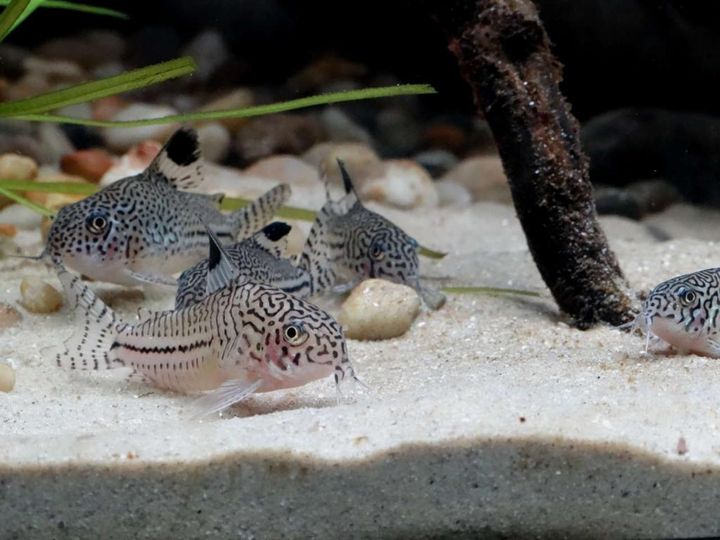Corydoras catfish care 
Cory Catfish can do well in covered tanks of nearly any size and dimensions. Many beginner hobbyists keep Corydoras Catfish in small tanks like 10 gallon (~40 liters) aquariums. Cory Cats can thrive in larger tanks too. Either way, hobbyists need to remember that all living species tax the bio-load capacity of a tank.
So it’s important to be mindful of fish count and overstocking. It’s also important to keep tanks thoroughly covered because Corys often dart up to the surface to grab a bite to eat or get a gulp of air. Hobbyists will often hear a snapping or popping sound as the Cory Cat breaks the water surface and moves quickly to the bottom of the tank. This is normal behavior and should not be considered a sign the water lacks oxygen, provided aquarium care is adequate.
Cory Catfish are very social creatures, especially with others of their kind. While Cory Cats can survive alone, they seem much happier in a group of two or more. Two Cory Cats of the same type will often stay close to one another as they move throughout the tank to feed. This is especially true when they rest. When one Cory Cat takes a break in the corner of a tank, other Cory Cats will almost always be seen an inch or two away. Two Cory Cats of different types may behave the same way. But in general, Corys of the same type seem to stick together most often.
If aquarium size permits, Cory Catfish school in groups of six or more. Cory Catfish schooling behavior is a pretty interesting thing to see as the fish move throughout the tank synced like a precision dance ensemble.
Depending on the specific type, Cory Catfish size can range from about 1 inch to about 2.5 inches (2,5–6 cm) in length.  Their diameter can range from about the size of a dime to about the size of a nickel. They are thicker near their heads and taper off near the tail, creating triangle shaped look.
Their diameter can range from about the size of a dime to about the size of a nickel. They are thicker near their heads and taper off near the tail, creating triangle shaped look.
A Cory Catfish is a bottom dweller, so it’s a good idea to keep at least 2 inches of aquarium gravel or substrate on the tank bottom. Cory Catfish also seem to really enjoy a tank with lots of live plants. Live aquarium plants provide cover and hiding places for the fish to rest. Finally, be sure to include rocks and decorations that provide places to explore. 

While Corydoras Catfish can do well in a wide range of water conditions, keeping the fish in established community tank water is a safe bet:
While aquarium pH and water temperature can extend beyond the traditional community tank range, it’s important to maintain stability. So avoid sudden shifts in conditions. Make sure Ammonia and Nitrite levels are kept at 0 ppm, and control Nitrate buildup with regular partial water changes.
Cory Cats do not do well in tanks with poor water conditions.  High Nitrates seem to stress Cory Cats and make them susceptible to diseases. Also avoid excessively stirring up the tank bottom while cleaning. This can release a large amount of decaying organic matter into the water column and start a bacterial bloom. The same goes for rearranging decorations. Corydoras Catfish may develop white patches around their mouths and barbels. This condition needs to be treated right away. If left untreated, Corydoras Catfish will stop eating, grow visibly thinner over time and eventually die.
High Nitrates seem to stress Cory Cats and make them susceptible to diseases. Also avoid excessively stirring up the tank bottom while cleaning. This can release a large amount of decaying organic matter into the water column and start a bacterial bloom. The same goes for rearranging decorations. Corydoras Catfish may develop white patches around their mouths and barbels. This condition needs to be treated right away. If left untreated, Corydoras Catfish will stop eating, grow visibly thinner over time and eventually die.
(read more: https://www.aquariumcarebasics.com/freshwater-aquarium-fish/cory-catfish)


